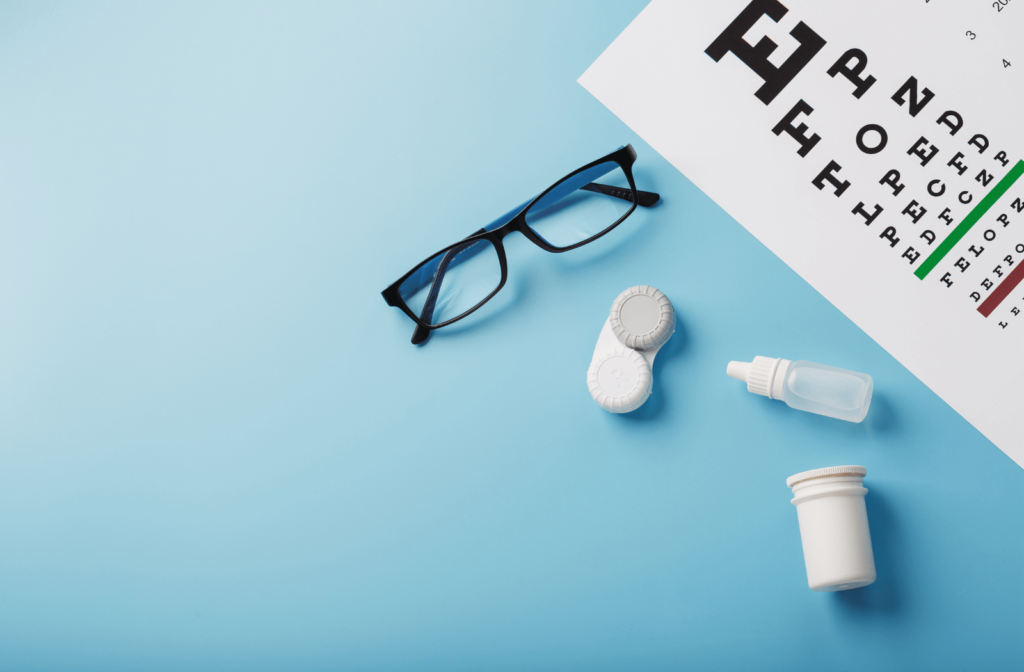The process for getting contact lenses differs from glasses. While you can get your glasses during a comprehensive eye exam, you need a contact lens exam for contacts. You need regular contact lens exams, but how often are these exams necessary?
Continue reading to learn more about contact lens exams, including how often you should have one and what to expect.
What Is a Contact Lens Exam?
A contact lens exam is how your eye doctor helps find the right contact lenses for your vision needs. You need this specialized eye exam because contacts are medical devices that sit directly on the eye. It’s imperative they fit well.
Your optometrist uses this exam to test how well you can see, measure and examine your eyes, and recommend contact lenses based on their findings. The prescription your eye doctor writes will differ slightly from your glasses prescription.
Your Contact Lens Prescription Explained
Many people assume glasses and contact lens prescriptions are the same. However, they have different lens powers, and you can’t use an eyeglass prescription for contact lenses.
Your glasses sit further away from the eye than contact lenses, while contacts rest directly on the eye. This difference means your contact lens prescription requires a different lens power to help you see clearly.
Your contact lens prescription has extra specifications determined by the measurements your optometrist takes during your exam. These measurements ensure a comfortable fit for your lenses.
How Often Should You Have a Contact Lens Exam?
You’ll need a contact lens exam every year if you wear contacts. Your contact lens prescription generally lasts for one year, and you need an additional exam to renew it so you can refill your lens order.
Contact lenses introduce more risks to your eyes than glasses, so your eye doctor needs these exams to look for potential problems or changes in your vision.
What Happens During Your Contact Lens Exam?
Your contact lens exam and fitting are similar to a comprehensive eye exam, except it features a few extra steps. Your eye doctor needs to determine the right contacts for your needs and what size of lenses you require.
Your contact lens exam includes patient history, eye measurements, tear film evaluation, and a trial period afterward.
Patient History
Similar to your regular eye exam, a contact lens exam includes a discussion with your optometrist. They’ll ask you several questions about your medical history, including family history, lifestyle, work and home life, and your previous experiences with contact lenses.
These questions help your optometrist learn how your eyes will handle contact lenses and what lenses may be ideal for your vision needs.
Eye Measurements
Contact lenses differ from glasses because they require several eye measurements to find the proper fit. They need these measurements due to the risk of complications associated with poorly fitted contact lenses. Contacts can hold too tight or loose, causing potential damage and further complications.
During your contact lens exam, your eye doctor measures your cornea to determine the right size and curve for your contact lenses. These measurements can also identify any irregularities in the eye caused by astigmatism. Additionally, pupil and iris measurements help your eye doctor find the ideal contact lenses for your needs.
Tear Film Evaluation
A tear film evaluation is another essential aspect of your contact lens exam. Your tear film consists of 3 layers (mucus, water, and oil) that hydrate and protect your eye’s surface, creating the tears that spread across the eye when you blink. Each layer of the tear film has a different purpose.
The mucus layer helps tears spread evenly across the eye and keeps them fastened to the eye’s surface. The water layer helps moisten and protect the eye from bacteria and debris. The oil layer prevents tears from evaporating too quickly.
The tear film is crucial when fitting contact lenses. Issues with your tear film can make contact lenses difficult or uncomfortable to wear and can worsen dry eyes. Your eye doctor will assess your tear film to see if your eyes will stay hydrated when wearing contacts.
Trial Period
After completing their examination, your eye doctor will recommend the contact lenses they feel best meet your vision needs. You don’t need to commit to these lenses right away—you’ll receive a pair of trial lenses to see how they fit and give you a chance to get used to them before committing.
After the trial period ends, you’ll have a follow-up appointment or phone call to assess how your contacts are working for you. Additionally, our expert staff will teach you to insert and remove your lenses and maintain them to avoid potential infections and damage.
Find the Right Contact Lenses for Your Needs
Contact lenses can provide clear and comfortable vision, but they require regular eye exams to ensure your eyes stay clear, happy, and healthy. Your eye doctor can help determine the right lenses for your needs and track any changes to your prescription.
Remember to book your contact lens exam every year, and you can enjoy wearing your lenses. Contact your optometrist at McCulley Optix Gallery when it’s time for your next contact lens exam.



